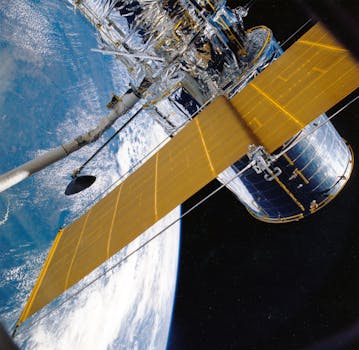
MEO Satellites: Unlocking the Power of Medium Earth Orbit Technology
MEO satellites, or Medium Earth Orbit satellites, are a type of satellite that operates in a medium-altitude orbit, typically between 2,000 and 36,000 kilometers above the Earth’s surface. This orbit is higher than Low Earth Orbit (LEO) satellites, which operate at an altitude of around 160 to 2,000 kilometers, and lower than Geostationary Orbit (GEO) satellites, which operate at an altitude of around 36,000 kilometers.
The MEO orbit offers a unique set of advantages, making it an attractive option for various applications, including telecommunications, navigation, and Earth observation. One of the primary benefits of MEO satellites is their ability to provide global coverage with a relatively small number of satellites, typically between 10 to 20, compared to LEO constellations, which can require hundreds or even thousands of satellites.
MEO satellites are also less prone to interference and signal delay compared to GEO satellites, as they are closer to the Earth’s surface. This results in faster signal transmission and lower latency, making them suitable for real-time applications such as video conferencing, online gaming, and remote desktop connections.
Applications of MEO Satellites
MEO satellites have a wide range of applications, including telecommunications, navigation, and Earth observation. In the telecommunications sector, MEO satellites are used to provide broadband internet services, mobile network connectivity, and broadcast services. They are particularly useful for providing connectivity in remote or underserved areas, where traditional terrestrial infrastructure may be limited or non-existent.
In the navigation sector, MEO satellites are used to provide location information and timing signals, which are essential for various applications, including aviation, maritime, and land transportation. The most well-known example of a navigation system using MEO satellites is the Global Positioning System (GPS), which consists of a constellation of 24-32 MEO satellites orbiting the Earth.
Earth observation is another significant application of MEO satellites, which are used to collect data on the Earth’s surface, atmosphere, and oceans. MEO satellites can provide high-resolution images and data on various parameters, such as temperature, humidity, and vegetation health, which are essential for weather forecasting, climate monitoring, and natural resource management.
Challenges and Future Developments
Despite the advantages of MEO satellites, there are several challenges associated with their development and operation. One of the primary challenges is the high cost of launching and maintaining a MEO satellite constellation, which can be prohibitively expensive for many organizations.
Another challenge is the risk of interference and signal degradation, which can be caused by various factors, including solar activity, atmospheric conditions, and human-made interference. To mitigate these risks, MEO satellite operators must implement advanced signal processing and interference mitigation techniques, which can add to the overall cost and complexity of the system.
Despite these challenges, the future of MEO satellites looks promising, with several new constellations and missions planned for launch in the coming years. One of the most significant developments is the launch of the O3b (Other 3 Billion) constellation, which aims to provide high-speed internet connectivity to underserved communities around the world.
Another exciting development is the use of MEO satellites for 5G and 6G wireless networks, which promise to provide faster data rates, lower latency, and greater connectivity than existing wireless networks. MEO satellites can play a crucial role in these networks, providing backhaul connectivity and extending coverage to remote and underserved areas.
Conclusion
In conclusion, MEO satellites offer a unique set of advantages and applications, making them a crucial component in modern telecommunications, navigation, and Earth observation. While there are challenges associated with their development and operation, the future of MEO satellites looks promising, with several new constellations and missions planned for launch in the coming years.
As the demand for global connectivity, navigation, and Earth observation continues to grow, MEO satellites will play an increasingly important role in meeting these needs. With their ability to provide global coverage, fast signal transmission, and low latency, MEO satellites are an attractive option for various applications, from telecommunications and navigation to Earth observation and scientific research.





